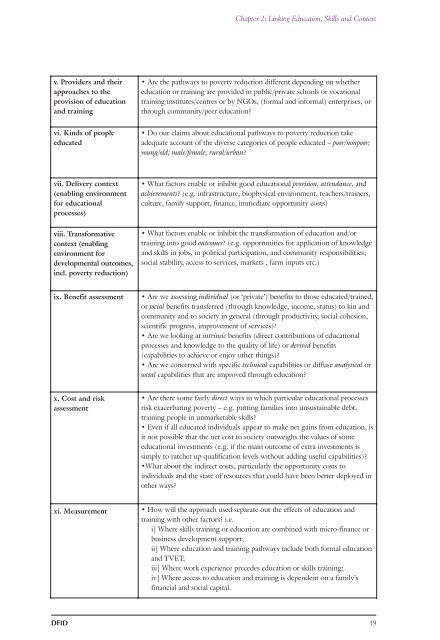Educating out of Poverty? A Synthesis Report on Ghana, India ... - DfID
Educating out of Poverty? A Synthesis Report on Ghana, India ... - DfID
Educating out of Poverty? A Synthesis Report on Ghana, India ... - DfID
Create successful ePaper yourself
Turn your PDF publications into a flip-book with our unique Google optimized e-Paper software.
v. Providers and their<br />
approaches to the<br />
provisi<strong>on</strong> <str<strong>on</strong>g>of</str<strong>on</strong>g> educati<strong>on</strong><br />
and training<br />
vi. Kinds <str<strong>on</strong>g>of</str<strong>on</strong>g> people<br />
educated<br />
vii. Delivery c<strong>on</strong>text<br />
(enabling envir<strong>on</strong>ment<br />
for educati<strong>on</strong>al<br />
processes)<br />
viii. Transformative<br />
c<strong>on</strong>text (enabling<br />
envir<strong>on</strong>ment for<br />
developmental <str<strong>on</strong>g>out</str<strong>on</strong>g>comes,<br />
incl. poverty reducti<strong>on</strong>)<br />
Chapter 2: Linking Educati<strong>on</strong>, Skills and C<strong>on</strong>text<br />
• Are the pathways to poverty reducti<strong>on</strong> different depending <strong>on</strong> whether<br />
educati<strong>on</strong> or training are provided in public/private schools or vocati<strong>on</strong>al<br />
training institutes/centres or by NGOs, (formal and informal) enterprises, or<br />
through community/peer educati<strong>on</strong>?<br />
• Do our claims ab<str<strong>on</strong>g>out</str<strong>on</strong>g> educati<strong>on</strong>al pathways to poverty reducti<strong>on</strong> take<br />
adequate account <str<strong>on</strong>g>of</str<strong>on</strong>g> the diverse categories <str<strong>on</strong>g>of</str<strong>on</strong>g> people educated – poor/n<strong>on</strong>poor;<br />
young/old; male/female; rural/urban?<br />
• What factors enable or inhibit good educati<strong>on</strong>al provisi<strong>on</strong>, attendance, and<br />
achievements? (e.g. infrastructure, biophysical envir<strong>on</strong>ment, teachers/trainers,<br />
culture, family support, finance, immediate opportunity costs)<br />
• What factors enable or inhibit the transformati<strong>on</strong> <str<strong>on</strong>g>of</str<strong>on</strong>g> educati<strong>on</strong> and/or<br />
training into good <str<strong>on</strong>g>out</str<strong>on</strong>g>comes? (e.g. opportunities for applicati<strong>on</strong> <str<strong>on</strong>g>of</str<strong>on</strong>g> knowledge<br />
and skills in jobs, in political participati<strong>on</strong>, and community resp<strong>on</strong>sibilities;<br />
social stability, access to services, markets , farm inputs etc.)<br />
ix. Benefit assessment • Are we assessing individual (or ‘private’) benefits to those educated/trained,<br />
or social benefits transferred (through knowledge, income, status) to kin and<br />
community and to society in general (through productivity, social cohesi<strong>on</strong>,<br />
scientific progress, improvement <str<strong>on</strong>g>of</str<strong>on</strong>g> services)?<br />
• Are we looking at intrinsic benefits (direct c<strong>on</strong>tributi<strong>on</strong>s <str<strong>on</strong>g>of</str<strong>on</strong>g> educati<strong>on</strong>al<br />
processes and knowledge to the quality <str<strong>on</strong>g>of</str<strong>on</strong>g> life) or derived benefits<br />
(capabilities to achieve or enjoy other things)?<br />
• Are we c<strong>on</strong>cerned with specific technical capabilities or diffuse analytical or<br />
social capabilities that are improved through educati<strong>on</strong>?<br />
x. Cost and risk<br />
assessment<br />
xi. Measurement<br />
• Are there some fairly direct ways in which particular educati<strong>on</strong>al processes<br />
risk exacerbating poverty – e.g. putting families into unsustainable debt,<br />
training people in unmarketable skills?<br />
• Even if all educated individuals appear to make net gains from educati<strong>on</strong>, is<br />
it not possible that the net cost to society <str<strong>on</strong>g>out</str<strong>on</strong>g>weighs the values <str<strong>on</strong>g>of</str<strong>on</strong>g> some<br />
educati<strong>on</strong>al investments (e.g. if the main <str<strong>on</strong>g>out</str<strong>on</strong>g>come <str<strong>on</strong>g>of</str<strong>on</strong>g> extra investments is<br />
simply to ratchet up qualificati<strong>on</strong> levels with<str<strong>on</strong>g>out</str<strong>on</strong>g> adding useful capabilities)?<br />
•What ab<str<strong>on</strong>g>out</str<strong>on</strong>g> the indirect costs, particularly the opportunity costs to<br />
individuals and the state <str<strong>on</strong>g>of</str<strong>on</strong>g> resources that could have been better deployed in<br />
other ways?<br />
• How will the approach used separate <str<strong>on</strong>g>out</str<strong>on</strong>g> the effects <str<strong>on</strong>g>of</str<strong>on</strong>g> educati<strong>on</strong> and<br />
training with other factors? i.e.<br />
i] Where skills training or educati<strong>on</strong> are combined with micro-finance or<br />
business development support;<br />
ii] Where educati<strong>on</strong> and training pathways include both formal educati<strong>on</strong><br />
and TVET;<br />
iii] Where work experience precedes educati<strong>on</strong> or skills training;<br />
iv] Where access to educati<strong>on</strong> and training is dependent <strong>on</strong> a family’s<br />
financial and social capital.<br />
DFID 19

















